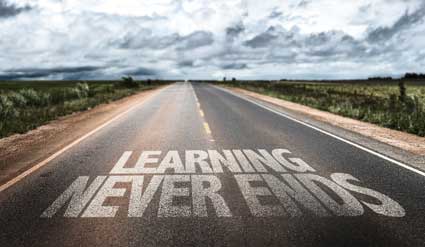As with most jobs and professions, there is no 100-percent typical day that every person in the profession will experience. Differences in age level, subjects, school culture, demographics, and even the regular teacher's classroom environment ensure that no single day substituting will be the same as the next. And so, the structure of each day spent substitute teaching would share characteristics with each other.
One important difference to note in typical substituting days is between elementary and secondary schools. Elementary substitute teachers, for the most part, will be with one group of students all day and cover several different subjects while secondary substitute teachers will often see several groups of students throughout the day for one subject. There are always exceptions to the rule, such as specialty teachers at the elementary level or some learning support teachers at the secondary level.
Preparing for the Day
The first step in substituting is getting the actual teaching assignment for the day. These calls may be made through telephone or Internet. When they come, the substitute teacher can accept or decline the assignment based on preference or availability.
After the substitute accepts an assignment, it is time to prepare for the day. The substitute showers, dresses, and otherwise gets physically ready for work. If the assignment is in a school new to the substitute, it is usually a good idea to "overdress" a little, meaning that it is always better to be dressed up a little too formally rather than dressed down too informally. Since school days are highly structured, there is not a lot of free time, so substitute teachers need to be prepared. Substitutes should pack a lunch and be sure that their bag or briefcase of resources is ready to go. Even though break time is usually at a premium, there may be instances where the substitute has an hour or more of time on their own. In those cases, it is better to be prepared ahead of time with a book or something else to keep busy.
Arriving at the School
Substitute teachers who are prepared, arrive at the school early, at least thirty minutes before the day starts. Upon arrival, the substitute checks in at the school office. At this point, most schools provide materials that the substitute needs for the day, keys, maps, attendance lists, schedule, lesson plans, and school rules and procedures. The types of materials may vary, but they will be helpful in getting through the day.
Preparing for the Students
When the substitute teacher arrives at the classroom, it is a good time to look over the school information, lesson plans, and other materials provided. The substitute familiarizes herself or himself with general school procedures if they are unfamiliar with them. This may include how to take attendance and lunch count, how to run announcements, how fire drills or other emergency drills work, and other duties that are expected. It is also the time to look over the day's lessons and see what is expected. The substitute needs to understand the instructions to make sure that the lessons go as smoothly as possible. It is also the perfect opportunity to gather and organize all the materials needed for the day's lessons so that the substitute is ready and can manage a smooth classroom.
Working with the Students
When the substitute teacher is prepared (or when the time comes), the substitute is ready to greet students. In elementary schools, students may have to be picked up from the playground, while in secondary schools, students usually come directly to the classroom. As students enter the room and are settled, some substitutes will talk briefly with one of the more attentive students about what the class is like and how the teacher maintains discipline. Some students will be very honest with the substitute and can be a source of valuable knowledge.
At the start of the school day, there is usually a school wide procedure for announcements, whether over the intercom or closed circuit television, and for attendance (and perhaps lunch count) to be sent to the office. Some schools send this information by student, others use a computer system. The substitute's materials should explain this. For the office, this attendance will be one of the most important things a substitute teacher can do for them, so accuracy is important.
The effective substitute will be sure to give a quick introduction and then instructions for the first task. This is where the listing instructions on the chalkboard come in handy. Keeping the students engaged in a task means that there is less room for behavior problems. The substitute follows the teacher's lesson plans as best as possible, collecting work that needs to be collected and assigning homework as instructed.
The substitute teacher continues through the day, following the schedule and interacting with different classes if assigned.
Wrapping Up the Day
When the day is done and the students have gone, the substitute wraps up the day. This involves leaving a written report. Some schools will require a written report to be left with the office about the day. Regardless, it is always a good idea to leave a written report with the teacher, even if it is not required. Teachers like to know how their classes behaved and what was accomplished during the day. This helps them better prepare for the next lessons.
In addition to leaving a written report, the substitute returns the classroom to the condition it was in the morning...or better. This includes straightening desks, cleaning the chalkboard, and returning materials to where they were found. Showing respect for the classroom and leaving the report are two ways to impress a teacher and improve your chances of being asked to return.
Checking Out
Assembling Your Resources
Now that you have a general idea of what a typical day of substitute teaching is like, it is the perfect time to put together all the resources that you could need for successful substitute teaching experiences. Some substitute teachers call these a "bag of tricks" since the most effective substitutes are prepared for any circumstance; they have "tricks" to handle any situation. To help you succeed at substitute teaching, It is best that you prepare these resources ahead of time so that you can be confident that you can handle what comes your way.
Your Voice
Before you can get into putting together physical things, you will probably want to evaluate one of your most valuable assets, your voice.After all, this is something that you will be using all day long. Successful teachers (both substitute and regular) know how to use their voices to their advantage. It is more than being loud and commanding; it is about knowing how to control and use your voice for the situation at hand.
Pretend that you are in front of a classroom giving instructions for an assignment. Record yourself, and then play it back to listen. Do you sound authoritative and in charge? On the other hand, do you sound meek or overpowering? Probably the best "teacher voice" is one that commands attention, respect, and is confident, but is not overbearing or diminutive. After all, you need to ensure that you can give directions to thirty or more students at a time, that they all hear you and that they know that you are serious. Practice how you would talk to a classroom of students, and try different ways to improve.
Your Clothes
Dressing the part is also important. For those first substituting assignments, how you dress is crucial in making the right first impression on both the students and school personnel. Simply put, it is better to overdress than underdress. If you are dressed more professionally than the teachers around you, the students will respond better to your authority than if you are dressed more casually.
Driving Directions9:31:36 PM
As most substitute teaching assignments are given early in the morning, you will be busy enough showering, dressing, and preparing lunch to worry about how to find the school, how long it takes to get there, and where is the main office. Instead, when you have been offered and accepted employment with a school district as a substitute teacher, make sure that you know where each school in the district is located. Print out driving directions to each school, and keep them with your substitute teaching materials. Even if you think you can simply find your way there, it is better to be safe than sorry in the hurried morning hours. Better yet, drive to each school from your home on your own time to get a sense of how long the trip will take, and when you are at each school, make sure that you know where to enter the building and where is the office.
Satchel or Briefcase or Bag
Have a sturdy, clean, and professional bag of some kind to tote your supplies to and from your substitute teaching assignments or from room to room (some teaching assignments do not have their own classrooms). Make sure that your bag is also large enough to carry all the supplies you need but also light enough to carry.
You will want to start with a folder or portfolio to keep in your bag. You can put the driving directions to the schools in this folder. You should also keep blank paper in your folder to take any notes that you will want to keep with you. You may be inspired about new ideas that you want to remember for future substituting assignments. Have a calendar or other system in place in your folder to keep track of your substitute teaching assignments, schools, teachers, grade levels, and subjects. This will help you keep track of your experience and history, especially if you plan to substitute at multiple schools or districts. This calendar also comes in handy so that you can accept other teaching assignments if you are asked by office personnel during the school day.
In addition to a folder and paper, you will want to keep plenty of writing instruments in your bag. Have plenty of chalk and dry erase markers for the board, number 2 pencils, pens with red and blue or black ink, and overhead projector markers. You can find all of these at an office supply or teaching supply store. While most classrooms will have writing instruments (and students are expected to have their own), there may be an occasional instance where you find nothing when you need it.
Some craft supplies are also things that some substitutes swear by. These could include markers, scissors, glue, and construction paper. Usually, these are supplies that you will not need, but there may be times, especially at the elementary level, when you will need to fill some time or that you need an emergency lesson plan that calls for a craft project. Your own whistle is something that you will want to keep in your bag. If you ever need to substitute for a physical education class, a whistle is indispensable for calling a gymnasium or field full of running students back to you. A whistle is also handy to get the attention of a class that may be getting out of hand.
For your own personal use, you should pack several supplies. Tissues, water, hair ties (if you have long hair), lozenges or cough drops, pain relievers, and a book or magazine to read if you have down time, are all useful. You will be on your feet and "on" for most of the day; your voice may get hoarse, and you may get a headache. Again, it pays to be prepared.
Emergency Lesson Plans
Finally, well prepared substitute teachers are ready with emergency lesson plans to use as fillers if there is extra time or in rare instances when no lesson plans are available. (This happens occasionally if there is an emergency that prevents a teacher from being there, and there was no time to plan accordingly.)
Bookstores and teaching supply stores often have skillbooks and workbooks for elementary aged children in reading, writing, and math. Buying a few of those ahead of time is smart as you can always make copies of pages to use as worksheets for elementary students.Age appropriate read aloud books also work with elementary students.Make or purchase flash cards for any subject. These kinds of time savers work especially well if you present a competitive element with teams earning points. Students will often pay strict attention if they know that candy (another item for your bag) is a prize for winning the most points.
It is usually harder to find resource books for secondary students, so you may not be able to track down workbooks to copy. (It is not usually a good idea to copy worksheets or activities from the teacher's own supplies; they may be saved for another lesson, and that would not reflect positively on your reputation.) Instead, you can gather crossword or Sudoku puzzles, brain teasers, and other similar activities. High school students also respond to candy awarded for the highest number of points!



























